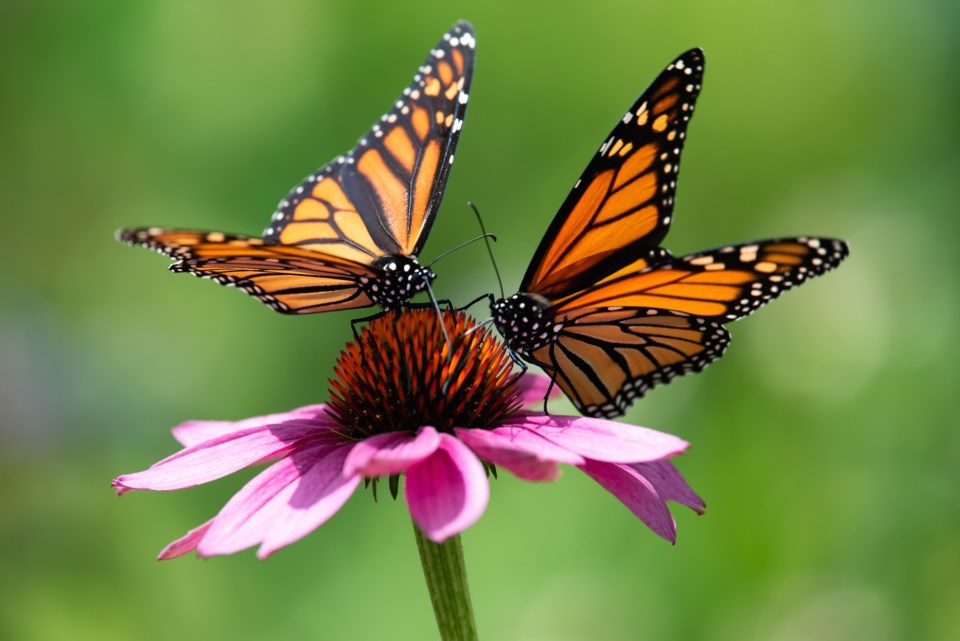NEWS RELEASE
BUTTERFLY PAVILION ENVIRONMENTAL AND ECOLOGICAL SERVICES
*************************
Butterfly Pavilion announces a new collaboration with Westside Investment Partners to leverage nearly three decades’ worth of experience transforming under-utilized land into biodiverse habitat to create new pollinator habitat within the former Park Hill Golf Course. Butterfly Pavilion’s pollinator habitat model is designed to conserve and protect pollinators in all aspects of community development and operation. Habitat restoration is the transformation of disturbed, fragmented, and/or monoculture landscapes into beautiful habitat that supports native pollinator species. This model of collaborative conservation creates pollinator habitat where people live and work, contributing to the food chain, economy, and overall human and ecosystem well-being.
Pollinators, such as honey bees, native bees and butterflies, play a critical role in ecosystem function and are vital to the human production of food and reproduction of native plants. Yet global pollinators are increasingly in peril, mainly from habitat destruction, chemical pollution, parasites, and pathogens which have significantly decreased their numbers. Flower-rich pollinator landscapes support greater biodiversity and climate resilience, supporting pollinators and other beneficial animals.
“We applaud Westside Investment Partners for recognizing the importance of pollinators and for their foresight to incorporate pollinator habitat into their development plans,” said Patrick Tennyson, President and CEO of Butterfly Pavilion. “As development and infrastructure increases throughout our region, Butterfly Pavilion is pioneering an innovative approach for incorporating pollinator habitat to help conserve and protect these valuable creatures.”
Protecting pollinators helps achieve multiple conservation goals: encouraging the protection of public green spaces, highlighting urban and rural interdependence, promoting the use of native plants in residential landscaping, and advancing environmental education at schools, communities, and with the general public.
“The new development and landscaping will engage all the people that live, work, and play in these spaces, encouraging them to experience nature and build a greater appreciation for these critical species and their habitats,” said Kenneth Ho, Principal at Westside Investment Partners, Inc. “We are leveraging Butterfly Pavilion’s scientific expertise to ensure protection and conservation of pollinators, while supporting greater biodiversity.”
The former golf course, which used more than 106 million gallons of water and several pesticides and fertilizers annually, closed in 2018. The proposal to redevelop this privately-owned land includes plans to donate two-thirds of the site — or more than 100 acres — for the creation of Denver’s fourth largest public park and 11th regional park. Water-intensive Kentucky Bluegrass sod will be replaced with drought-resistant landscaping, including approximately 1,000 trees and native plant palettes, to restore biodiversity throughout the site.
“We are thrilled that this innovative partnership with Butterfly Pavilion can help transform this former golf course into a model for urban pollinator districts across the state,” said Ho. “Butterfly Pavilion is an internationally recognized leader in advancing the protection and conservation of pollinators, and we’re thrilled to leverage their deep expertise.”
Butterfly Pavilion’s habitat development model is a blueprint for creating, improving, and sustaining pollinator habitat and has been used throughout Colorado, while rolling it out internationally beginning with Turks and Caicos. Habitat enhancements are integrated into engineered green spaces such as rain gardens, bio-swales, green roofs, public shared areas, and residential neighborhoods.
Baseline in Broomfield, Colorado, where Butterfly Pavilion will be building its new facility in the coming years, has already shown an increase of pollinators where new habitat was planted just a few years ago. The future of pollinator habitat is more than creating and sustaining the habitat but includes an education and research component.
“After development we’ve actually seen more biodiversity at Baseline where Butterfly Pavilion started a survey of invertebrate habitat in 2019 before any development had been underway,” said Amy Yarger, Horticulture Director, Butterfly Pavilion. “Only three short years later, where residents have moved into newly developed housing, there has been an increase of pollinators observed in the habitat-friendly landscaping at Baseline.”
*************************


.jpg;w=120;h=80;mode=crop)
